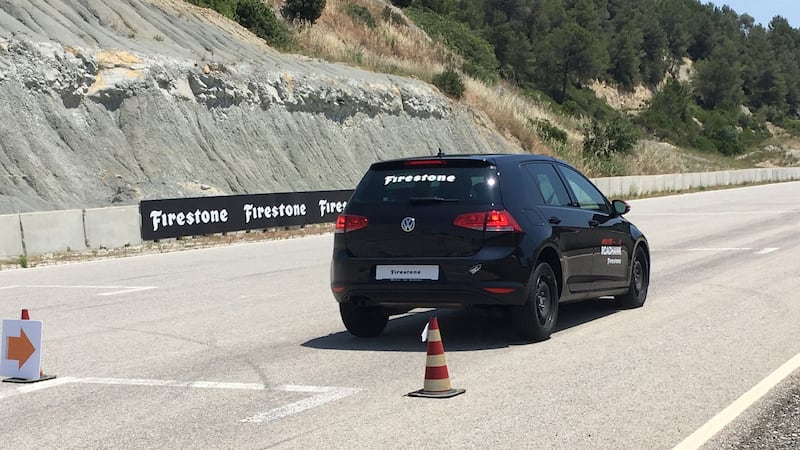Writing 800 words on tyres is the sort of punishment normally reserved for students caught smoking in the toilets, or for carrying out an extreme wedgy on a classmate. I’m guilty of neither.
Tyres are generally regarded as a stress purchase. It’s up there with phoning a plumber or going to the dentist for a filling. Even amongst a gathering of the most hardcore of petrolheads, while there will be praise for gleaming alloys, you’re unlikely to hear someone exclaim “love your tyres”.
While there are plenty of “specialist” parts of the internet for rubber fans, it usually only crops up in polite conversation in its vulcanised form when an NCT is due or after a warning from a garda when the tread depth is close to the legal minimum of 1.6 mm.

Yet with most cars creating just an A4-sized tyre footprint on the road surface, the quality of the tyres fitted is absolutely critical to how the car turns and stops.
Most drivers buy what they can afford or go for the cheapest option, but this can often be a false economy. The problem is that reality only bites here in the worst possible circumstances.
Mid-priced market
The big tyre firms operate in the market in a similar way to washing detergent firms by offering multiple brands at different price points for what is seen as pretty much the same thing. Bridgestone-branded tyres are a premium offering but the firm offers a couple of sub brands at lower price points. Bridgestone's Firestone brand is a mid priced tyre while its budget brand in Europe is called Dayton.
At the Parc Motor test track near Barcelona we put Firestone’s new Roadhawk touring tyre through its paces. The Roadhawk is designed to perform longer, claims to offer best in class wet weather grip and deliver excellent dry braking. So it was time to put the claims to the test.
We tested new and part worn tyres in the most popular 16-inch wheel size from Firestone against tyres from Uniroyal, a sub-brand from arch-rival Continental Tyres.
At our disposal were two identical Volkswagen Golfs, one was fitted with 205/55 R16 Roadhawks and the other Uniroyal Rainsport 3. Both are similarly priced, with the 16 inch Roadhawk costing about €85 per tyre. The next wheel size up 225/45 R17 priced at abut €110 per tyre.
Slightly worn grips better
We tested both tyres under severe braking on the track’s finishing straight and also pushed their wet weather cornering ability to the limit on an infield circuit.
During the emergency braking tests on dry surface, a Firestone expert explained that worn tyres actually stop much better on a dry track due to the tread blocks being stiffer when worn down - much like racing slicks.
At speeds of 100km/h, the Roadhawk equipped car performed best, stopping almost two metres shorter than the rival. The other tests were done using worn tyres from both manufacturers with about 20,000 kilometres on them.
According to the experts, there is very little difference in new tyre performance from all the main brands, but with wear, it is a different story.
The worn Roadhawk in our testing held on to its performance properties longer than the Rainsport 3. Not surprisingly with the Uniroyal the limit of adhesion was exceeded sooner than with the Firestone.
Slippery when wet
We also carried out a test on a wet roundabout that involved going as quickly as possible in second gear with the ESP stability control system switched off. The Roadhawk held the line. There were also lane-changing tests, and comfort assessments, all showcasing the Roadhawk’s ability.
Of course all these were under the auspices of a Firestone event, so it was hardly going to show the new tyres in a bad light. Yet the test themselves did reflect the sort of everyday conditions many Irish drivers encounter. And while you might take these findings with a pinch of salt - we don’t claim they are scientific - I can vouch for the results from the driver’s seat.
The Japanese brand Bridgestone has a well-earned reputation as a premium tyre retailer, but it's US sibling is still trying to rebuild its reputation, tarnished by a major recall in the US at the turn of the century.
Along with focussing on the on-road grip, it’s also tapping into its heritage. Founder Harvey Firestone made a bit of a name for himself sponsoring music talent shows on radio in the US from 1928.
In a retro move, the current management are hosting 17 music festivals across Europe this year, including one last weekend in Drogheda, Co Louth. Trying to make tyres rock 'n roll - now that makes writing 800 words on tyres seem like a doddle.


















